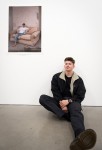Personal reflection and contemporary conversation inspired 19 art students to give a physical form to societal debates.
Bennett Simpson, the senior curator at The Museum of Contemporary Art, chose works from a pool of nearly 100 applicants for the UCLA Department of Art’s annual undergraduate exhibition. The exhibition, located in the Broad Art Center’s New Wight Gallery, is open until Thursday. Malaya Johnson, a second-year art student and a featured artist, said the exhibition doesn’t subscribe to a certain theme, but rather focuses on the style of each individual artist while commenting on social topics.
“I think everyone is making very critical work and it’s nice to see how much love and attention they all put into it,” Johnson said. “A lot of the work helps you become a better thinker, and I think anyone can gain something out of that.”
The Juried Exhibition is Johnson’s first show, and she is excited to see how students interact with the dialogue her piece is meant to inspire, she said. She crafted a sculpture titled “Untitled (or, Burnt Sacrifice)” which takes the form of an altar with pill bottles used as candles, and said the piece is meant to be an honest work that explores the intersection between religion and mental health. Johnson said the inner turmoil caused by both religion and mental health allowed her to observe parallels between the two. The ritualistic practices found in religion and the act of taking a pill daily are both recurring processes of healing that aren’t typically associated with one another, she said.
[RELATED: Graduate student explores concept of framing and perception in art exhibition]
Jack Garell, a second-year art student, submitted a photograph of himself on a couch, wrapped in a poncho of recycled plastic materials, as part of the exhibition. The photograph is originally from a series of three pieces entitled “Plastic People,” which is meant to remind onlookers that everyday use of plastic is something everyone should remain aware of and work to limit. Although Garell began photographing eight years ago, he said his interactions with accomplished photography professors and assignments in an introductory film class have encouraged him to contemplate why he photographs and the relevance behind each of his works.
“(The photograph) is about our mindless use of plastic and how we don’t put a lot of conscious thought into how we’re using it. I wanted to do a self-portrait to include myself in that conversation because I feel like sometimes people leave themselves out or talk about society objectively, but I’m part of the issue,” Garell said. “I’m contributing to that consumer culture.”
Fourth-year art student Gozie Ojini has a sculpture entitled “Portal” in the exhibition, created from a beaded curtain hung from a walk-through metal detector. The beads of the curtain spell out quotes from the various perspectives of fellow students, faculty and district attorneys concerning the use of metal detectors in schools and the psychological effects they have on students. He said he hopes seeing familiar objects, such as a metal detector, in a gallery context will shift people’s perspectives on their use of the objects outside an artistic setting. While the metal detector functions properly, it will remain unplugged during the exhibition due to the legal codes of the gallery space.
[RELATED: Exhibit explores optimism, beauty amid political climate]
Despite the fact that his sculpture will not function at the level he wanted, Ojini said he still encourages students to visit the gallery and contribute to the discussion each featured piece confronts. Johnson said one of an artist’s greatest fears is that they are shouting into an empty void, but participation in the exhibition offers her an opportunity to open a dialogue about her piece with the public. Garell said it is important for people to see what kind of art students are making now and the different ways in which they’ve manifested their ideas in relation to contemporary issues.
“We’re trying to tackle issues here that we feel are important,” Ojini said. “We’re trying to bridge the gap between people who think art is this elitist thing, but what we’re actually trying to do is communicate.”
Simpson declined to comment.

MOCA was and remains to one of the main centers of art in Los Angeles and other countries. This museum one of those art museums with constantly changing presentations of the modern art. It is located in the center of Los Angeles and very beautifully issued also friendly for the audience. Very pleasantly is in it. Exhibits in MOCA often change and always is on what to look. The student’s exhibition was organized top-level. All works were creative and had raised the issue of environmental pollution. I write the assignment quickly and then have visited the exhibition. There very much it was pleasant to me and I will visit more often in this museum.